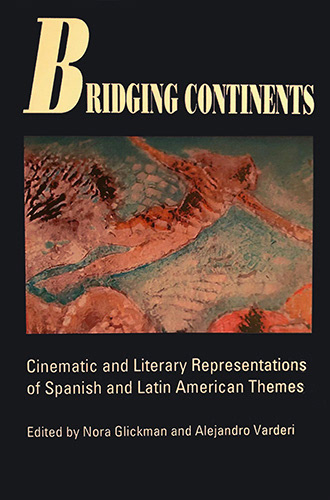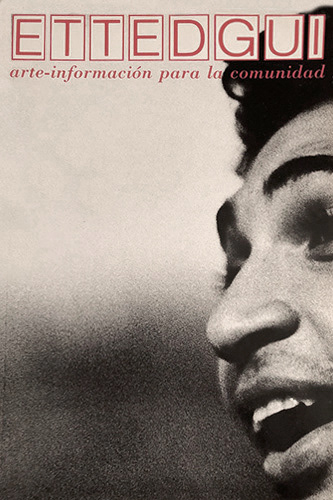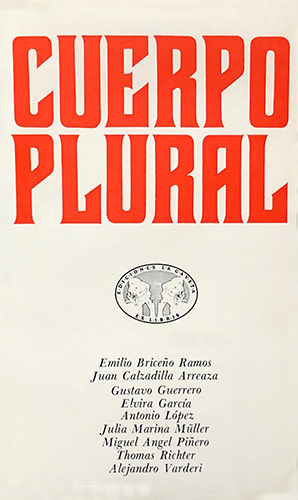OTRAS PUBLICACIONES
OTHER PUBLICATIONS
Admiracions por Marta Pessarrodona
Brooklyn: Cuadernos de humo, 2019, 43 páginas.
Los poemas incluidos en el tríptico Admiracions responden a “what’s on her mind”, en cuanto al procès de autodeterminación y expresan su solidaridad con los inculpados, a raíz del referéndum independentista del 1 de octubre de 2017.
Presentación y traducción, al español y al inglés, del tríptico Admiracions de la autora catalana Marta Pessarrodona.
Presentación y traducción, al español y al inglés, del tríptico Admiracions de la autora catalana Marta Pessarrodona.
The poems included in Admiracions resonate with what’s on her mind regarding Catalonia’s procès of self-determination, and reflect her solidarity with the indicted for their involvement in the October 2017 Independence Referendum.
Presentation and translation, into Spanish and English, of Catalan author Marta Pessarrodona’s tryptic Admiracions.

El amor a Barcelona por Marta Pessarrodona
Caracas: bid & co., 2016, 51 páginas.
Como el Dublín de James Joyce, el Berlín de Christopher Isherwood, el Londres de Virginia Woolf —otras dos de sus grandes pasiones— el Nueva York de Hart Crane o el Buenos Aires borgiano, la Barcelona de Marta Pessarrodona se articula de modo que sus “parajes” sean siempre memoria para quienes, aun viviendo lejos de ella, puedan devolverse desde el texto y rehacerla.
Presentación y traducción al español del poemario L’amor a Barcelona de la autora catalana Marta Pessarrodona.
Like James Joyce's Dublin, Christopher Isherwood's Berlin, Virginia Woolf's London —two of her great passions — Hart Crane's New York or Borges’s Buenos Aires, Marta Pessarrodona's Barcelona takes shape as such that its “spaces” will always enclose the memories of those who, even living away, might go back to the text and recover it.
Presentation and translation into Spanish of the poetry book L’amor a Barcelona by Catalan author Marta Pesarrodona.
Like James Joyce's Dublin, Christopher Isherwood's Berlin, Virginia Woolf's London —two of her great passions — Hart Crane's New York or Borges’s Buenos Aires, Marta Pessarrodona's Barcelona takes shape as such that its “spaces” will always enclose the memories of those who, even living away, might go back to the text and recover it.
Presentation and translation into Spanish of the poetry book L’amor a Barcelona by Catalan author Marta Pesarrodona.

Briging Continents: Cinematic and Literary Representations of Spanish and Latin American Themes. Nora Glickman, coeditora.
Tempe: Chasqui, 2005, 230 páginas.
Tras la Guerra Civil y la Segunda Guerra Mundial, España vivía aislada del mundo, intentando reconstruir su economía bajo la dictadura franquista. Censura, escasez, desempleo y una sangrienta división social y política habían traumatizado a la población. Ante tales circunstancias, el cine se transformó en el espacio para el duelo y la sanación; y la experiencia cinemática fue la ruta de escape hacia lejanas tierras manufacturadas por los estudios de Hollywood y de Cifesa.
Este estudio crítico reúne ensayos de 16 especialistas en el área del cine y la literatura, tanto de España como de Latinoamérica. Ello, con el fin de crear un puente entre la producción que se realiza a ambos lados del Atlántico. La colección abarca textos y películas que trabajan estos temas desde la época colonial hasta hoy.
Tempe: Chasqui, 2005, 230 páginas.
Tras la Guerra Civil y la Segunda Guerra Mundial, España vivía aislada del mundo, intentando reconstruir su economía bajo la dictadura franquista. Censura, escasez, desempleo y una sangrienta división social y política habían traumatizado a la población. Ante tales circunstancias, el cine se transformó en el espacio para el duelo y la sanación; y la experiencia cinemática fue la ruta de escape hacia lejanas tierras manufacturadas por los estudios de Hollywood y de Cifesa.
Este estudio crítico reúne ensayos de 16 especialistas en el área del cine y la literatura, tanto de España como de Latinoamérica. Ello, con el fin de crear un puente entre la producción que se realiza a ambos lados del Atlántico. La colección abarca textos y películas que trabajan estos temas desde la época colonial hasta hoy.
In the aftermath of both, the Spanish Civil War and World War II Spain, under Franco regime, was an isolated country struggling to rebuild its economy. Censorship, shortages, unemployment, and a bloody division along political and social lines had traumatized the Spanish population. Under such circumstances the movie theater doubled as a place for mourning and healing, and the cinematic experience became the exit route to a faraway land manufactured at the Hollywood and at the Spanish Cifesa studios.
This critical study brings together essays by 16 specialists in the area of cinema and literature, both in Spain and Latin America. This, seeking to build a bridge between the film and literary production on both sides of the Atlantic. The collection includes texts and films that work on these issues from Colonial times to the present.

Ettedgui: arte-información para la comunidad
Caracas: Oxígeno, 1985, 245 páginas.
El nuevo arte. Los novísimos venezolanos somos los artistas más preparados para subsistir en medios agresivos desde Michelangelo.
Este volumen reúne textos en poesía, teatro y performance del artista venezolano Marco Antonio Ettedgui (1958-1981). Incluye también textos introductorios de Juan Calzadilla y Elsa Flores, así como fotografías de las intervenciones urbanas de Ettedgui realizadas por Julio Vengoechea.
The new art. The latest Venezuelans are the best trained artists for surviving in aggressive conditions since Michelangelo.
Caracas: Oxígeno, 1985, 245 páginas.
El nuevo arte. Los novísimos venezolanos somos los artistas más preparados para subsistir en medios agresivos desde Michelangelo.
Este volumen reúne textos en poesía, teatro y performance del artista venezolano Marco Antonio Ettedgui (1958-1981). Incluye también textos introductorios de Juan Calzadilla y Elsa Flores, así como fotografías de las intervenciones urbanas de Ettedgui realizadas por Julio Vengoechea.
The new art. The latest Venezuelans are the best trained artists for surviving in aggressive conditions since Michelangelo.
This volume is a selection of poetry, theater and performance by Venezuelan artist Marco Antonio Ettedgui (1958-1981). It also includes introductory essays by Juan Calzadilla and Elsa Flores, as well as photographs by Julio Vengoechea documenting Ettedgui’s urban happenings.

Ritos Cívicos
Caracas: La Gaveta, 1980, 112 páginas.
Evite que los tubos eléctricos, rollos, palas mecánicas, ganchos y tenazas le resequen el pelo, usando un poco de agua para humedecer las puntas. Pero no se olvide de anteponer el letrero: “Obreros en la vía. Perdone la molestia. Hacemos una nueva ciudad”.
Este libro colectivo del grupo de La Gaveta Ilustrada (1976-1981), escrito a ocho manos bajo el seudónimo José María Acomedido, reúne una serie de instantáneas urbanas donde la ciudad es el auténtico protagonista. Incluye también textos de Emilio Briceño Ramos, Juan Calzadilla, Elvira García, Gustavo Guerrero, Antonio López Ortega, Julia Marina Müller y Miguel Ángel Piñero.
Caracas: La Gaveta, 1980, 112 páginas.
Evite que los tubos eléctricos, rollos, palas mecánicas, ganchos y tenazas le resequen el pelo, usando un poco de agua para humedecer las puntas. Pero no se olvide de anteponer el letrero: “Obreros en la vía. Perdone la molestia. Hacemos una nueva ciudad”.
Este libro colectivo del grupo de La Gaveta Ilustrada (1976-1981), escrito a ocho manos bajo el seudónimo José María Acomedido, reúne una serie de instantáneas urbanas donde la ciudad es el auténtico protagonista. Incluye también textos de Emilio Briceño Ramos, Juan Calzadilla, Elvira García, Gustavo Guerrero, Antonio López Ortega, Julia Marina Müller y Miguel Ángel Piñero.
Avoid electrical tubes, rolls, mechanical shovels, hooks and tongs drying your hair, using a little water to moisten the tips. But don't forget to put up the sign first: “Men Working. Sorry for the Inconvenience. We Make a New City.”
This collective book of the La Gaveta Ilustrada group (1976-1981), written by eight different hands under the pseudonym José María Acomedido, brings together a series of urban snapshots where the city is the real protagonist. It also includes texts by Emilio Briceño Ramos, Juan Calzadilla, Elvira García, Gustavo Guerrero, Antonio López Ortega, Julia Marina Müller and Miguel Ángel Piñero.
This collective book of the La Gaveta Ilustrada group (1976-1981), written by eight different hands under the pseudonym José María Acomedido, brings together a series of urban snapshots where the city is the real protagonist. It also includes texts by Emilio Briceño Ramos, Juan Calzadilla, Elvira García, Gustavo Guerrero, Antonio López Ortega, Julia Marina Müller and Miguel Ángel Piñero.

Cuerpo Plural
Caracas: La Gaveta, 1978, 167 páginas.
Por eso, he derruido la casa, con ella dentro, para que así los ladrillos, el desván, las muñecas y sus discos de Vivaldi se le envuelvan en el pelo, los encajes y los lazos negros de sus zapatos y se queden ahí como cubriéndola.
Esta antología del grupo editor de la revista La Gaveta Ilustrada, reúne textos de los miembros del taller literario de la Universidad Simón Bolívar, dirigido por el escritor, artista plástico y crítico Juan Calzadilla. Los restantes integrantes de la antología fueron: Emilio Briceño Ramos, Juan Calzadilla Arreaza, Gustavo Guerrero, Elvira García, Antonio López Ortega, Julia Marina Müller, Miguel Ángel Piñero y Thomas Richter.
That is why I have demolished the house, with her inside, so that the bricks, the attic, the dolls, and her Vivaldi records will envelop her hair, the lace and the black ribbons of her shoes, and will remain there, as if covering her.
This anthology by the editors of La Gaveta Ilustrada magazine, is a collection of texts written by members of the Universidad Simón Bolívar literary workshop led by writer, artist and critic Juan Calzadilla. It also includes texts by Emilio Briceño Ramos, Juan Calzadilla Arreaza, Gustavo Guerrero, Elvira García, Antonio López Ortega, Julia Marina Müller, Miguel Ángel Piñero and Thomas Richter.
Caracas: La Gaveta, 1978, 167 páginas.
Por eso, he derruido la casa, con ella dentro, para que así los ladrillos, el desván, las muñecas y sus discos de Vivaldi se le envuelvan en el pelo, los encajes y los lazos negros de sus zapatos y se queden ahí como cubriéndola.
Esta antología del grupo editor de la revista La Gaveta Ilustrada, reúne textos de los miembros del taller literario de la Universidad Simón Bolívar, dirigido por el escritor, artista plástico y crítico Juan Calzadilla. Los restantes integrantes de la antología fueron: Emilio Briceño Ramos, Juan Calzadilla Arreaza, Gustavo Guerrero, Elvira García, Antonio López Ortega, Julia Marina Müller, Miguel Ángel Piñero y Thomas Richter.
That is why I have demolished the house, with her inside, so that the bricks, the attic, the dolls, and her Vivaldi records will envelop her hair, the lace and the black ribbons of her shoes, and will remain there, as if covering her.
This anthology by the editors of La Gaveta Ilustrada magazine, is a collection of texts written by members of the Universidad Simón Bolívar literary workshop led by writer, artist and critic Juan Calzadilla. It also includes texts by Emilio Briceño Ramos, Juan Calzadilla Arreaza, Gustavo Guerrero, Elvira García, Antonio López Ortega, Julia Marina Müller, Miguel Ángel Piñero and Thomas Richter.